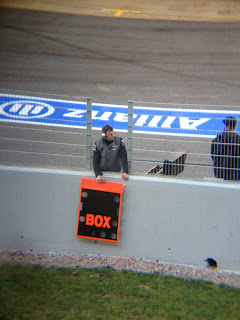All teams surround their garages by secrecy shields during
testing, but some create a more extensive mask.
So which team has the most to hide? Red Bull were, without doubt, the most furtive
in Barcelona. While the other teams pull
the cars back into the garage in full view of photographers and fans following
a run, Red Bull pull their screen out to totally eclipse the RB9 on its
return.
Their attempts at concealment didn’t stop there. A silver shrouding blanket was evident,
thrown over the top of the car to further hide it from onlookers.
In contrast to their current nemesis, Ferrari were very open
on day one of testing at the Circuit de Catalunya. There was no attempt to cloak the F138 as Fernando
Alonso was wheeled in and out of the garage for all to see and almost as a
spectacle for anyone watching, the nose was changed in the pit lane.
Day two saw Ferrari behaving a little more secretively as
they sheltered their car by ensuring the garage door was pulled down to meet
the secrecy screen, perhaps due to the problems suffered with their exhaust
pipe. Likewise, Mercedes adopted the
same method of obscuring their car from view, particularly on Tuesday when they
didn’t manage as much running as they would have liked due to a gearbox
issue. Also suffering gearbox issues,
the Lotus garage was highly shielded for the majority of the day.
With Red Bull leading the development race for the last
three years at the hands of aero wizard, Adrian Newey, it is understandable
that they should want to hide any evolutions for fear of rivals emulating what
they see. However, their extraordinary
attempts at concealment are laced with arrogance. Their belief that they are superior and
therefore will be the main focus for rival’s interest is far from endearing. They are not the most adored team in the
paddock, a badge that often comes hand in hand with continued success,
especially when the team lacks the history that Ferrari, Williams and McLaren
possess.
Like the driving of Michael Schumacher, Red Bull are
synonymous with pushing the boundaries, taking things to the limit. In 2012 numerous developments made by the
team were deemed questionable under technical regulations. The
holes in the floor ahead of the rear wheels on the RB8 were questioned before
the Monaco Grand Prix. Although not
resulting in a protest, they were told to remove this design feature before the
next race in Canada. Prior to the German
Grand Prix at Hockenhiem, the FIA were alerted to the fact that Red Bull were
running a questionable torque map by their technical delegate Jo Bauer. It was decided that it didn’t breach
regulations, but the removal of it was ordered in time for the next race in
Hungary. This was followed by the ‘rideheight’
issue that emerged at the Hungaroring, when it was reported that a request had
been made for the team to abolish the function to change the rideheight
manually. Red
Bull are well renowned for taking development to the edge and are especially
skilled at it.
So what are Red Bull hiding?
Do they have a revolutionary, on the edge development under wraps or are
they creating smoke and mirrors because they don’t? With other teams such as Williams revealing
interesting changes to their car for the 2013 season, Red Bull may be feeling
the pressure, possibly fuelling mind games.
Their overzealous approach to creating mystery around testing could just
be an illusion. One that will be
shattered in Melbourne.






































